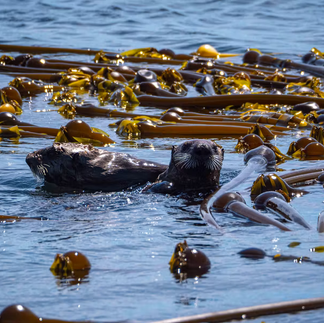IF YOU DON'T APPRECIATE ALGAE AND SEAWEED, READ THIS!!!!!!!!!!!!!!
- Eliza Dale

- Jun 10, 2022
- 2 min read
Hopefully we all know that oxygen comes from trees...But what if most of it doesn't?Scientists have estimated that the ocean makes around 50-80 percent of the worlds oxygen! But how does that happen? Well seaweed and algae are responsible! That's crazy.

As you can see, from the photo below, seaweed also provides a safe area for many marine species. Animals also eat algae and seaweed. These creatures include crabs, shrimps, turtles, pufferfishes, starfishes, betta fishes, krills, lobsters, and eels.
Between 2014 and 2015 alone, a underwater heat wave caused a nearly 95% decline in Northern California kelp canopies. Similar heatwaves, along with pollution, caused global kelp forests continue to decline by about 2% every year! "2% that's not that much." Actually it is for the thing that is in the group of plants that provides over half of the worlds oxygen!

Kelps also create rafts for birds and otters to sit on! When strands of kelp break loose, they clump together. The raft along with the small sea creatures it carries can travel hundreds of miles, bringing species to new places. Scientists have even documented the arrival of a kelp raft in Antarctica carrying a bundle of non-native species, founding new concerns over kelps ability to spread invasive species to new habitats. Maybe kelp isn't always a good thing.
We all know that one person, you don't see them for 2 months and they are now a full head taller than you. Would you believe me if I told you that some seaweeds can grow a foot a day! Well it's true. For the giant kelp, a single kelp can produce hundreds of kelp fronds, fronds are kelp leaves. Individual kelp fronds can grow to be over 30 meters long!
Seaweed is also farmed as a crop. Globally, kelp aquaculture is part of a $6 billion seaweed farming industry!

Kelp forests are found throughout the world including along the west coasts of North and South America, the southern tip of Africa and Australia, and islands near Antarctica. They can be found on over 20% of the worlds coats lines.
Algae are vital in many food chains, many fish feed on algae as well as other life forms. Algae can also be used in human medicines and food!
Seaweed and algae also help remove huge amounts of Carbon Dioxide! What a amazing thing!

Does algae and seaweed have roots? No they don't! In fact, they don’t grow underground at all. Instead, each kelp attaches to a rock or a solid structure. This may be why you can see them floating at the beach, because they have been unattached.
Hopefully after reading this, you appreciate algae and seaweed more. Whether that be for the air you breath or a home for animals. Next time your swimming in the beautiful water and seaweed touches your foot, hopefully you think back to this post and think how important all plants are!













Comments